Fly Fishing the Delaware River: A River of Hopes and Dreams
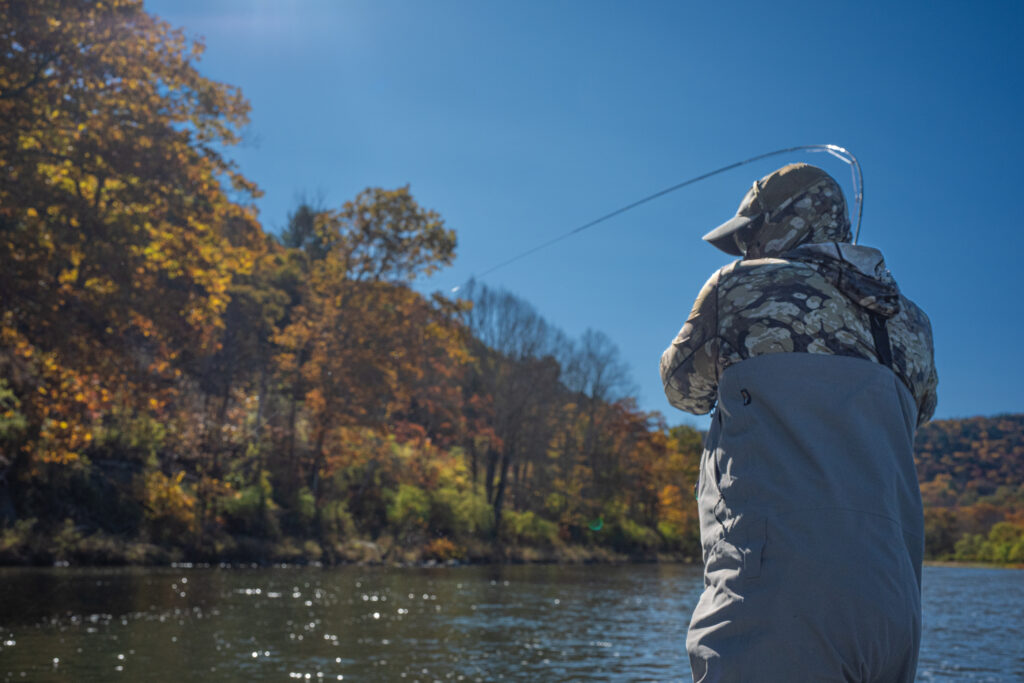
A particularly productive piece of water began where boulders pockmarked a run, funneling current along a gravel bar. More rocks, pockets and a sharp drop completed the prime habitat. Sam’s perfectly placed cast hurled the olive and white Briny Muddler onto the edge of the gravel bar. A hard snap of the rod activated the sinking head, diving the articulated streamer down the decline. Again, snap and strip. Another snap of the rod and slam! Sam was tight to his second twenty plus inch brown trout of the day, a breathtaking hook jawed male.
The runs, rapids, and eddys of the Delaware harbor many brown and rainbow trout, smallmouth bass, striped bass, walleye, shad and, in some places, even muskie. An extraordinary fishery, the Delaware beckons fly fishers desiring a serious challenge with the potential for unforgettable rewards.
What exactly can a flyrodder expect to encounter when fishing the Delaware? I am glad you asked! Let’s step into my literary drift boat and float down the river and through the seasons as I introduce you to one of the best fisheries in the lower 48.
The Upper Delaware River is comprised of the West and East Branches which meet in Hancock, forming the Main Stem. Much of the West and Main Stem mark the border between New York State and Pennsylvania. The Cannonsville reservoir on the West and Pepacton reservoir on the East release from the bottom, creating a continual supply of clean, cold water habitat and an outstanding tailwater fishery. These releases forge excellent trout fishing as far down as Callicoon, New York, for all but the toastiest summer weather. When the typical hot weather of July and August arrive, the lower Main Stem transitions to an excellent warmwater fishery. Generally, anglers seeking trout should fish the West Branch or Upper East Branch above its junction with the Beaverkilll River during the warm summer months. With typical Spring and Autumn temperatures, all of both branches and the Main Stem provide excellent trout fisheries once again. Below Callicoon in cooler weather, there are pockets of trout and a robust warmwater fishery.
The West Branch offers anglers the most access and, as long as you are willing to walk from the access areas, some of the most accessible nymphing runs in the system. The East has some access, but not as much as the West. The Main Stem has the least access and is definitely best fished with a drift boat and guide or personal watercraft. All three sections of the system offer sensational streamer and dry fly fishing. The West Branch, which has several lodges located on the river, has the most fish per mile and, as such, receives enormous pressure (both drift boats and wading anglers) during the prime times of late April through June. The East Branch does not get as much pressure, nor does it have as many fish per mile. The East Branch offers solitude and sizable trout, if not the quantity of the West. The Upper Main Stem, the stretch from Bard Parker through the Buckingham boat launch, has the most fish on the Main Stem. As you descend the Main Stem toward Callicoon, fish population density decreases; however, the average size increases. The Main Stem, a massive trout river, is often over 500 feet wide and too deep to wade. Public access is very limited.
The Delaware, considered one of the best (and most technical) dry fly fisheries in the country, awakens each Spring with the Hendrickson hatch. Typically beginning in late April, fish feeding to dry flies can be found every day of the season until the minute blue wing olives of Autumn stop hatching sometime in November.
Hints of mint green from streamside foliage formed the backdrop as the first Hendricksons of the year poked through the water’s surface. Beyond the sight and range of any public access, I anchored my drift boat close to shore so Eric Lindh could wade into position and fire off a reach cast to the rising trout. A dry dropper featuring a Paraschuck as the dry and a Barr Emerger dropper formed a lethal tandem, tempting trout as the apple once had Eve. Within minutes Eric was tight to a tempestuous rainbow trout that ripped Eric into his backing. By the time the hatch slowed, I had netted four wild, belligerent and beefy trout for Eric. Relatively rare are days when you catch double digit numbers of trout on the Delaware – it is a river where you trade quantity for exquisite quality.
Later on the float, I spied a fish dimpling along the bank, under pine branches extending out over the water and behind a boulder. As quietly as I could, practically holding my breath, I maneuvered the boat into position and dropped the anchor as softly as if I was trying not to wake a baby who had just fallen asleep. Stealth is demanded for spooky bankfeeders – one false move and they vanish! Picking flies from the surface, the trout continued to rise in rhythm to Hendricksons. Eric tied on a Snowshoe Emerger and worked casts, each effort getting longer and landing closer to the target. After a countless presentations, twenty one inches of buttery brown trout sipped the floating fraud. The matriarch exploded, frothing the surface then furiously racing downstream then across. The heavyweight bout ended as Eric guided her into my net.
Mayfly Hatches
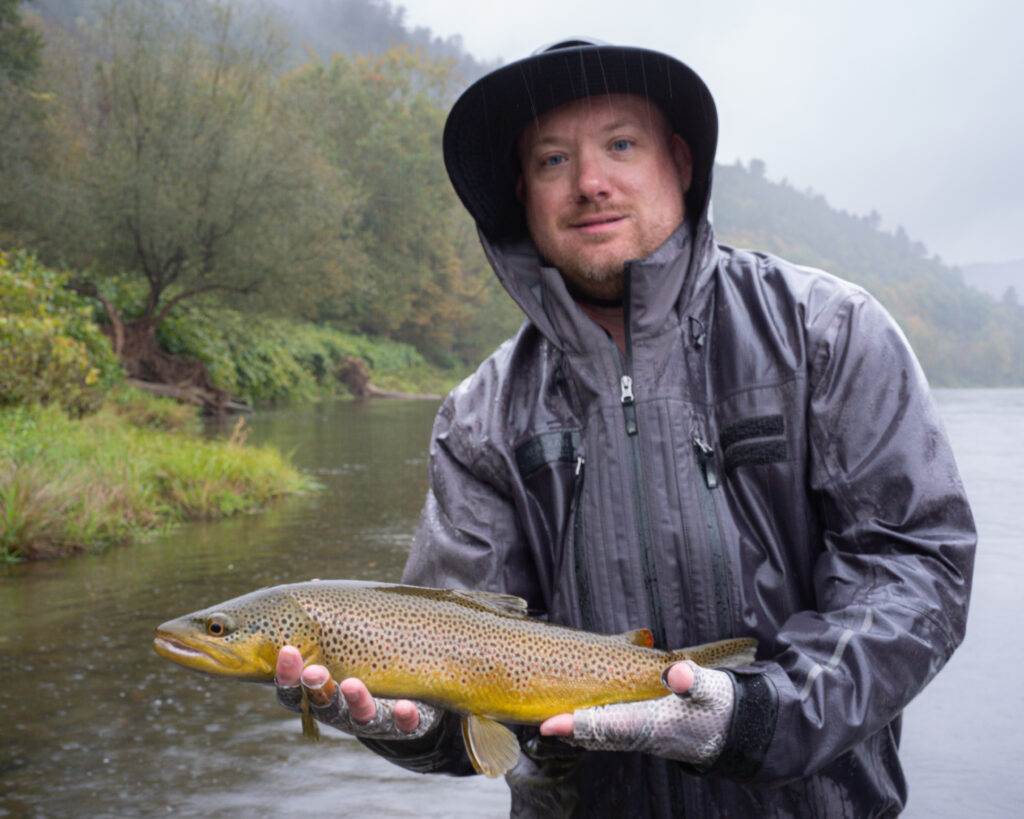
Anglers target the dense Delaware River mayfly hatches. Famous events like the hallowed Hendricksons, Green Drakes, Gray Foxes and Isonychia ignite outstanding dry fly action. But lesser-known hatches like the Pink Cahill and Little Hendrickson can provide excellent angling, as well. Possibly the most important hatches on the river are Blue Wing Olives and Sulphurs, as one species or another hatches from the middle of May through early November. The two weeks surrounding Memorial Day are known as big bug weeks and sharpies stalk the big fish that surface feed during those hatches.
It is a mistake to dismiss caddis hatches. There are times when the trout take adult caddis, but pupa are typically more important. There are three excellent times to fish caddis. Most morning hours do not see strong mayfly hatches, but caddis often hatch early; in fact, I have fond memories of finding fish taking caddis pupa and adults on many Spring mornings.
A second time to fish caddis pupa is before an expected hatch. Sulphur mayflies hatch in June evenings, usually as the sun is setting. In the hour before the hatch starts, a tan or green caddis pupa swung across a riffle will take trout before the Sulphurs start.
The third time I like to fish pupa is whenever I see fish rising upstream. Rising Delaware trout are best caught on dry flies when fishing across or down and across. They are notoriously difficult to take if they are rising upstream. These fish are more likely to take an emerger or caddis pupa fished just under the film when they are feeding upstream of the angler. Size 14 – 18 caddis in green, tan, olive and grayish brown are all productive. Spring and fall caddis hatches are so thick it can look like it is snowing!
The July summer Sulphur hatch just below either reservoir is, in a word, epic! Activity will begin as early as noon. Heavy feeding continues until about 4:00. There is a lull, but action erupts around 7:00 and continues well into dark. Fishing is very challenging: often anglers mumble as they return to their vehicles, frustrated at their inability to take fish despite the boiling water surrounding them. There is much more going on during this hatch than meets the eye.
Most days on the water, early in the hatch there are many more midges hatching than sulfurs. Reading riseforms and seining the water reveals the nearly invisible insects. For the first two hours, try a dry dropper with a Zelon Midge as a dry and a super sparse pupa as a dropper. You will be shocked at the size fish you can take under bluebird skies in water less than 18 inches deep. Twice last year we hooked fish we could not turn! Fish typically run from a foot to seventeen inches with some bruisers mixed in. As the day progresses, the midges will wane (but not completely stop) and sulfur nymphs will dominate the flow. Finally, for the last hour or so, Sulphur adults form the primary forage.
Last season, the lull between afternoon and evening hatches witnessed one of the best catches of the year. Rick had called and asked me to guide his son, Zander. During the morning, Zander managed several fish on Sulphurs and midges.
We were between hatches, experiencing some fine river dining, when I saw subtle rises along the bank. Zander swallowed the last of his late lunch, unhooked his Zelon Midge and started to cast. Zander, despite his relative youth, is quite the angler. His third reach cast was poetry in motion – perfection – and the trout sipped in his midge. With 7x tippet, size 20 fly, and a patient yet persistent fight, Zander bested seventeen inches of beefy brown trout.
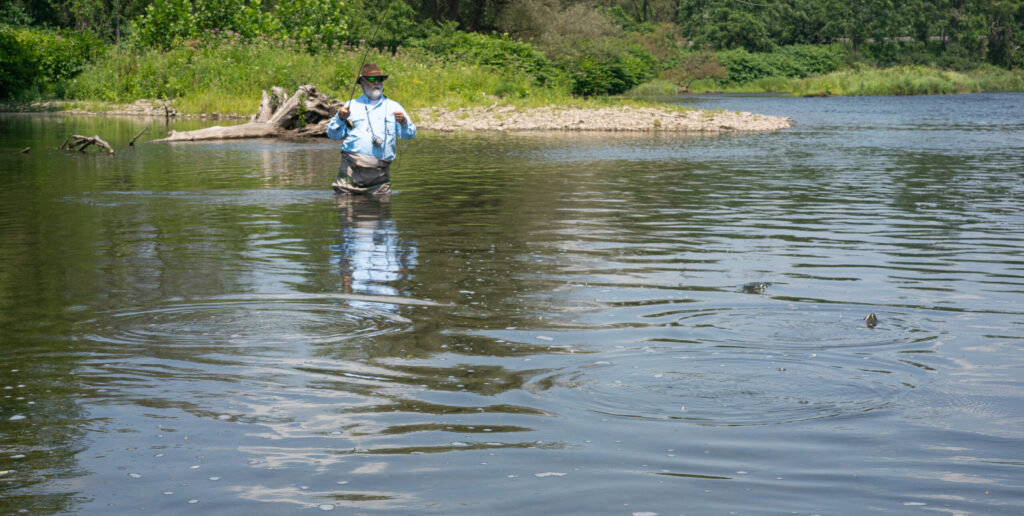
The mix of dry fly and streamer action on this waterway is to be treasured. I met Brian through a mutual friend, and we were getting to know each other better one particular float. I adjusted the oars and drifted toward a huge rock with a cleft which created a secondary current that, a few feet below, mixed with the main flow.
“This is a special spot,” I offered. “Last year I raised an enormous fish right below that cleft, where the currents come together. He took a March Brown Sailboat Dun, thrashed around on the surface for several seconds and was gone. I never got the hook in him. If I had to bet, I would say that Tortuga may have hit two feel long.” I could tell by the look on Brian’s face that he suspected more myth than truth in my recollection.”
Brian, a tremendous streamer fisherman, started false casting…
His Copper Top streamer plopped in the secondary current, pierced the surface and headed for the confluence of the currents just below the cleft. One sharp pull and pow! The water exploded with a crushing strike from a big brown trout. The water frothed as the behemoth raged. Several seconds later, silence as the brute sank back to the bottom. Brian turned to me, “I will never doubt another word you say.”
The Delaware Holds Many Secrets
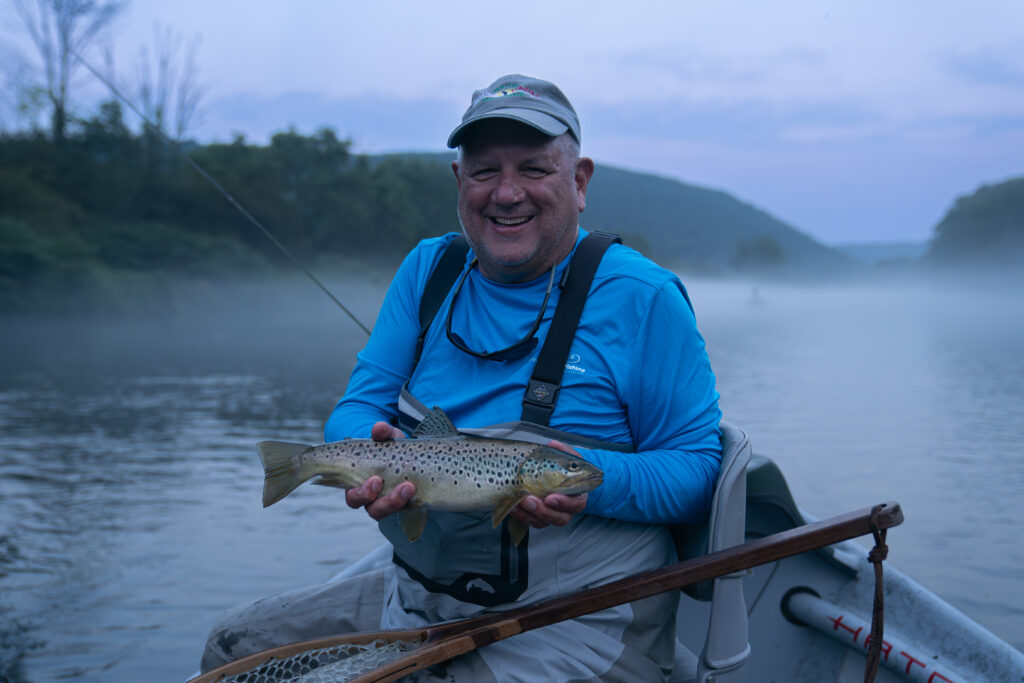
Pulling my truck into the driveway, the autumn air had a touch of chill when Mike Bachkosky pointed to a chair, inviting me to sit and watch the rising trout below his house. “Hey, how’s the fishing been for you?” Mike asked.
“Real good. Had a lady take a sweet bow up above in the run yesterday. I think we got 10 or 12 for the day. The trout are starting to feed hard.”
I first met Mike in the spring of 1984, watched his every move from afar and dared not open my mouth. A novice, I watched in awe as Mike hooked, fought, and landed the Delaware’s famed wild rainbows one after another. I caught nothing, trip after trip that spring.
One day the following spring, Mike waved me over and invited me to sit on a rock with him. “I see you out there trying but it’s not working for you. Do you want to catch fish?”
“Absolutely.”
“The first thing you have to realize is that everything else is checkers. The Delaware is chess. Forget all the stuff that works on hatchery fish and easier rivers. These fish are wild, wily, and have PhDs. They hold MENSA meetings.”
For forty years, Professor Bachkosky’s Delaware River trout fishing wisdom has informed and directed my understanding of this magnificent river. The first rainbow trout I ever caught in the Delaware made all other trout I had ever caught seem like paltry imitations. The 16-inch dynamo twice took me into my backing and jumped more times than any fish I had ever hooked before. I have never fished out West, but fly fishers I respect have told me that only the rainbows of the famed Madison and Deschutes Rivers compare.
Looking out over the Fly Tier’s Pool (Bachkosky is the fly tier for whom the pool is named), we saw six or seven trout starting to rise while we talked. I mentioned that I was taking a mutual friend, Mike Madden, out the next day. Bachkosky declined my offer to join us but offered some advice. “Autumn is my favorite time to fish the river. Make sure you bring some Sulphur and Olive Unusuals.”
The Unusual is Mike’s variation of the famous Fran Betters pattern, the Usual.
The water leading into Fly Tier’s Pool is one of Mike Madden’s favorite runs on the river. Pseudos (tiny Olives) densely dotted the surface as far as the eye could see. Preparing for the long winter, rainbow trout gorged on the mini morsels, the head, then dorsal, then tail rises flashing pink.
A Davy Knot lashed an Olive Unusual to the leader. Mike focused on one particular trout rising in rhythm. His cast perfect, Mike followed the drift. Mike struck as the rainbow rose. Cartwheeling and careening first right then left, the fly line made a ninety degree bend beneath the surface. More acrobatics gave way to determined, bulldog runs that ripped the backing from the reel. Mike bested the bow and 15 inches of a fat, pink-sided and formidable fish slid into the net.
The next day Rich Strolis and Mike Rice joined me for a drift, sporting only streamer rods. Rich (catchingshadows.com) ties some of the best flies (especially streamers) available anywhere, and Mike is an outstanding photographer. Both can flat out catch fish. Many walleye, smallmouth, brown and rainbow trout all fell for their feathered frauds.
Rich took a brown over 20 inches and Mike managed a stunning rainbow that bettered 19 inches. But the best part of the day was when, in a shallow riffle, Rich casted behind a boulder in a shallow run. A sharp pop of Rich’s rod snapped the fly to life. A few jerks later and a monstruous, Tortuga-shaped shadow shot from beneath the boulder, giving chase to Rich’s fly. He snapped at it twice, but missed the fly each time. As the beast returned to its boulder Rich exclaimed, “Did you see that fish. That thing was huge!”
I have tried countless times to capture in words why we fly fish, never fully encapsulating the notion. The look on Rich’s face fully, perfectly expressed why.

Fall on the Delaware
Purple and yellow skies mixed with fall foliage and reflected on the Delaware’s surface as the autumn daylight dwindled. We spotted a lone fish working to the last of some hatching Hebe mayflies. Delicate oar strokes put us in position as Rich readied a dry fly rod I had brought along. Each cast was a clue to the adjustments Rich needed to make in his presentation.
With an exceptional cast, Rich rose the rainbow. The surface’s reflected colors erupted as the rainbow leapt toward the sky, spitting the hook. In the unseasonably icy air of the day’s last light, Rich got the dry fly eat. This water wonderland has unparalleled streamer and dry fly challenges. Two or three more weeks of this action and the river would, like much of the wildlife lining its banks, hibernate for a few months. When the river warms, the Hendricksons will hatch again.
____________________
Bob Lindquist lives on the banks of the Delaware River in Callicoon, NY. He guides on the Delaware River and teaches fly fishing and tying at flyfishing shows and at club meetings from Virginia to New England.
Have a fly fishing question you’d like answered? Drop us a line at info@darkskskiesflyfishing.com! If we use your question in a blog post or in the newsletter, we’ll send you a FREE fly box with a dozen of our favorite nymphs and dry flies!
